Feb 25, 2024
Comac Steals the Limelight in Singapore With First Peek of C919 Jet
, Bloomberg News

(Bloomberg) -- Comac and its C919 single-aisle jet emerged as unlikely stars of the 2024 Singapore Airshow, with the Chinese planemaker’s large chalet, several aircraft on display, and presence in the vast exhibition hall drawing throngs of onlookers and curious dignitaries.
“Crowded,” is how one flight attendant for China Eastern Airlines Corp., the only Chinese airline that flies the C919, described it, noting she’d observed executives from all sorts of companies and countries showing up for a peek inside Comac’s hospitality tent, where wait staff delivered Chinese delicacies to those trying to escape Singapore’s searing humidity.
For Commercial Aircraft Corp of China Ltd., as Comac is formally known, the Singapore air show was its first big international aviation event, a chance to debut the C919 on the world stage. Between flying displays, Comac top management, including Chairman He Dongfeng and Chief Technical Officer Ren He, were keen to broaden sales beyond Asia’s biggest economy.
Traction wasn’t bad. Comac signed Tibet Airlines to 40 C919s and won an endorsement from Saudi Arabia’s Riyadh Air as an emerging rival to Boeing Co. and Airbus SE.
Riyadh Air’s Chief Operating Officer Peter Bellew said Comac will become a major force in the international aircraft manufacturing industry in the next decade as it emerges as an alternative to the world’s planemaking duopoly. “I’m sure they will build a world-beating aircraft in the next 10 years,” said Bellew, a former chief executive officer of Malaysia Airlines. “I wouldn’t underestimate Comac for one minute.”
Even Boeing’s Commercial Marketing Managing Director for the Asia-Pacific region, Dave Schulte, said the US planemaker expects to one day start competing with Comac’s C919 for aircraft sales. The C919, which isn’t yet certified to fly passengers outside of China, is almost as big as Boeing’s 737 Max.
Read more: Will Boeing Woes Help China’s Comac Bust Jet Duopoly?: QuickTake
So far, however, Comac has managed to hand over four C919s to its only airline customer in China Eastern Airlines Corp. The Shanghai-based carrier has subsequently ordered a further 100 jets.
Airbus’s Commercial Aircraft Chief Christian Scherer identified Comac as a future competitor as it grows but said the C919 “isn’t going to rock the boat in a significant way.”
Comac itself meanwhile is working on a plan to become more self-sufficient in terms of suppliers, according to people familiar with the matter, with a long-term goal of replacing all US-export controlled components of the C919.
The plan, codenamed C9X9, is a response to US-issued export licenses for several crucial parts that aren’t being approved regularly and are therefore impacting upon Comac’s ability to boost jet output, the people said, declining to be identified because the information is private.
Avoiding potential risks of being sanctioned would also ultimately allow Comac to sell its jets to nations more receptive to Beijing, like Iran or Russia, another person said.
One change already underway is around the engines the C919 uses, one person said. They’re currently supplied by CFM International Inc., the joint venture between General Electric Co. and Safran SA. Comac is instead targeting using the CJ1000 turbofan jet engine being developed by Aero Engine Corp. of China, the person said. To that end, CJ1000 engines are already on a Comac test plane, they added.
Representatives for Comac didn’t immediately respond to a request for comment. Aero Engine Corp. also didn’t respond to a request for comment.
However replacing all international — or even US-made — parts will be an uphill battle for Comac. The manufacturer relies to a huge degree on North American companies for components, including from Honeywell International Inc., which supplies the axillary power units to all Comac’s C919 wheels, cockpit systems and displays, and its jets’ braking systems.
Some of that complexity was on display at the Singapore air show, when Comac allowed a select few on board one of its C919 planes flown by China Eastern.
Here’s a look at the inside of that jet — an aircraft few people outside of China may ever have the chance to fly.
Comac has handed over four C919s to China Eastern. The Shanghai-based carrier has subsequently ordered a further 100 jets.
The C919 seats a maximum of 192 people and is intended to compete with the best-selling Airbus A320 and Boeing 737 planes. Its business class looks decidedly basic versus some other carriers.
China Eastern made its inaugural flight with the C919 on the Shanghai-Chengdu route, and the airline has since taken delivery of another three aircraft, adding flights between Shanghai and Beijing on Jan. 9.
In all, Comac says it has received 1,061 orders from Chinese carriers and airline lessors. The inside of the plane however looks a lot like any other, with catering trolleys, seats and tray tables that wouldn’t look out of place in any airline.
The C919’s engines are currently supplied by CFM International. But Comac is instead targeting using the CJ1000 turbofan jet engine being developed by Aero Engine Corp. CJ1000 engines are already on a Comac test plane, a person familiar with the matter said.
--With assistance from Ocean Hou, Angus Whitley and Yihui Xie.
©2024 Bloomberg L.P.


